5 Steps To Handle A Leaky Roof

Here is a five-step plan to help any and every Florida homeowner handle and correct the situation whenever a roof leak pops up during a local rain storm:
1. Contain The Immediate Problem
When you see a leak, immediately put a bucket or pan or other container below it to catch all the water. Then waste no time in searching through other parts of your home to see if there are any other leakage points in other rooms so you can catch that water too.If water is streaming out so fast that it splashes out of the bucket bottom onto the carpet, then put some old towels or clothes in the bucket to stop the splashing. Or, run a string from the ceiling at the leak point so the water will travel straight into the bucket. If paint is bubbled out, then puncture it with a needle so the water is released into the bucket below.
2. Assess The Damage
Empty the buckets as needed during the storm. Once the rain stops falling and the leak stops flowing, clean up and dry up any water that is on your floors. Dry all wet ceilings, walls, floors, and woodwork, so that you don’t give mold or mildew a chance to develop.
Now do an initial self-assessment of the damage done. Hopefully, there is not permanent damage done but only a water entry point through your roofing into your home that needs to be stopped. But, if drywall, furniture, or anything else is damaged, make a list of it.
3. Contact Your Insurer
First of all, you should contact your homeowners’ insurance company and inform them of any damage done to your home and of the presence of the roofing leak. Your insurer can explain to you what will or will not be covered and maybe help you arrange for a repair with a local roofing contractor.
On the other hand, if you don’t have a homeowners’ policy or the leak won’t be covered, you can certainly just find a good roof repair expert on your own.
4. Fix The Leak
An experienced roofing contractor can quickly and safely locate the leakage point on your rooftop. It’s not always straight up from the leak through the ceiling, but roofers have experience in finding even elusive leaks.
It may only take an hour or less to fix a roofing leak in some cases, when done by professionals, and the results are typically much better and long-lived than with the DIY route.
5. Prevent Future Leaks
Finally, make sure you trim back trees overhanging your roof, fix any broken roofing caulk or out of place flashing, and clean out the gutters/downspouts to help prevent future leaks.
And be ready to contact a reliable, local roofer, like Sheegog Contracting in Central Florida, so you won’t waste any time searching for your roofer last-minute should a future leak occur.


